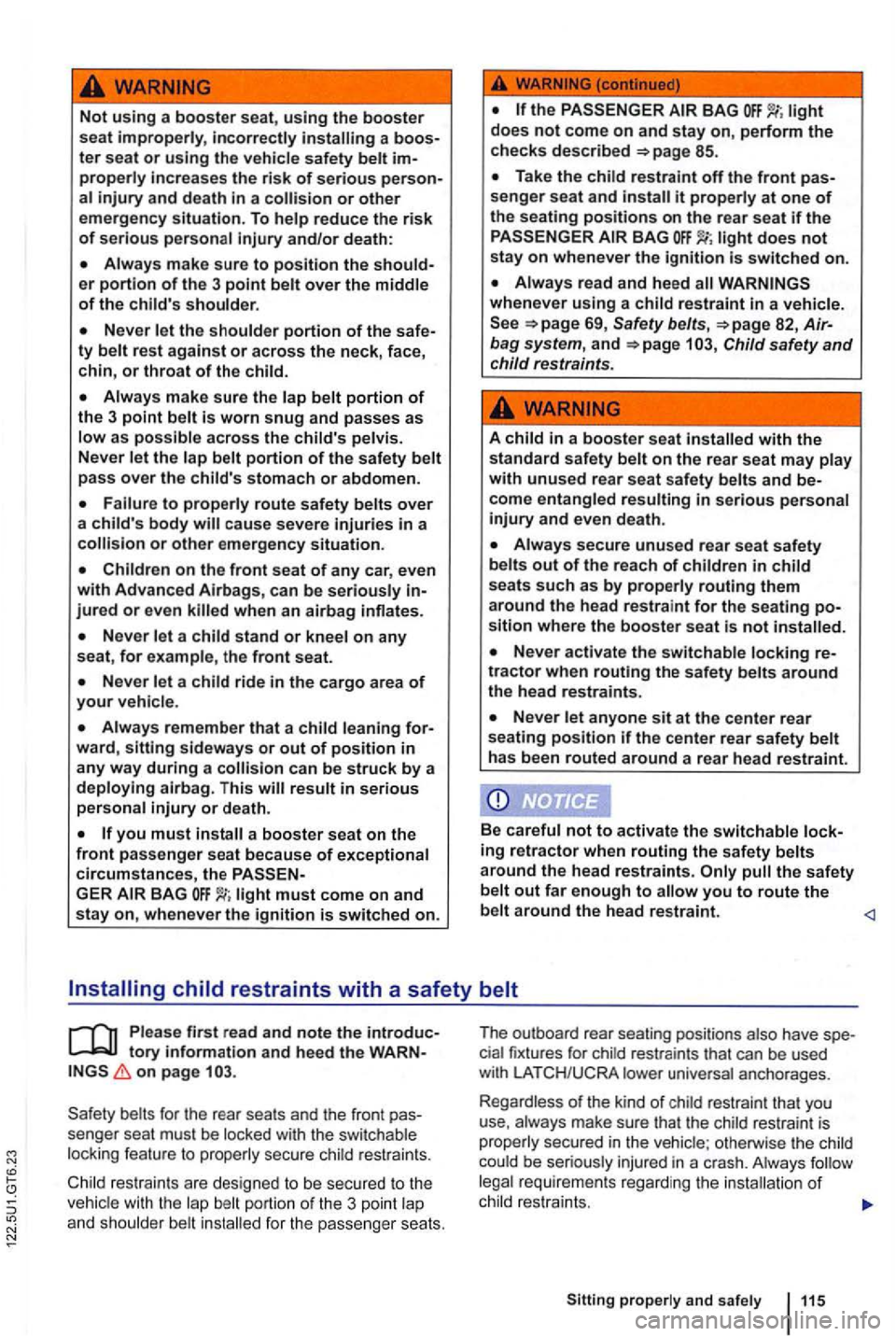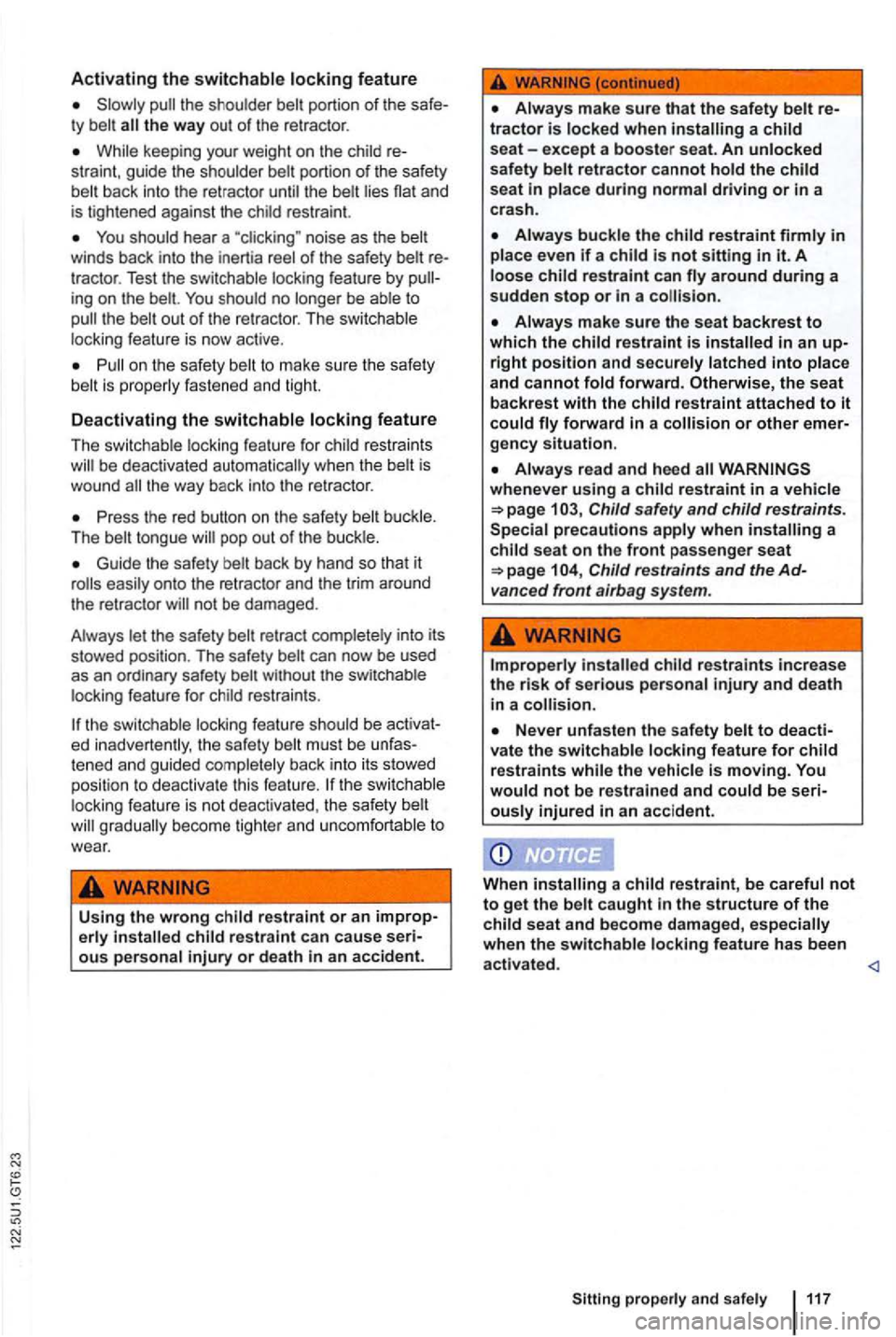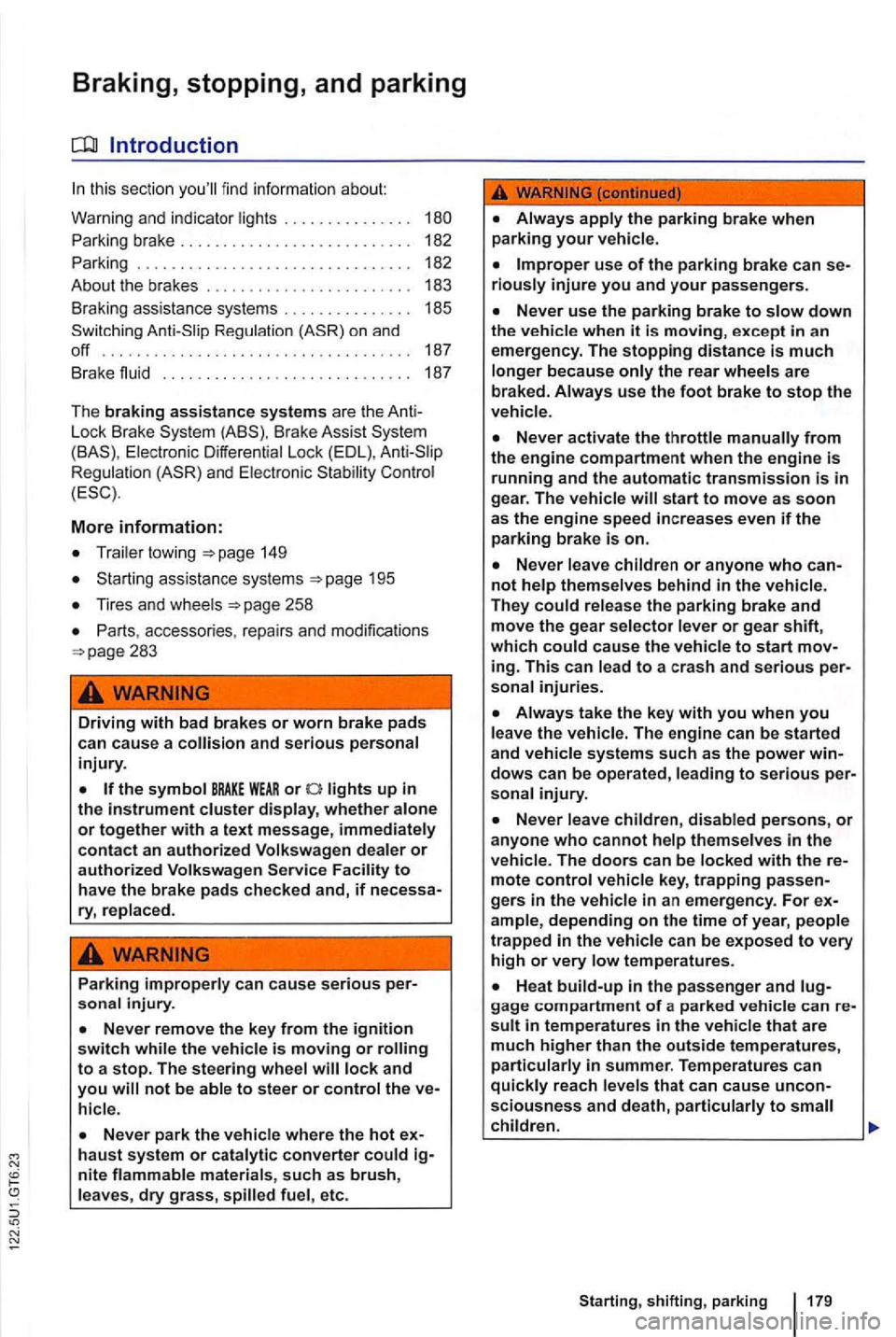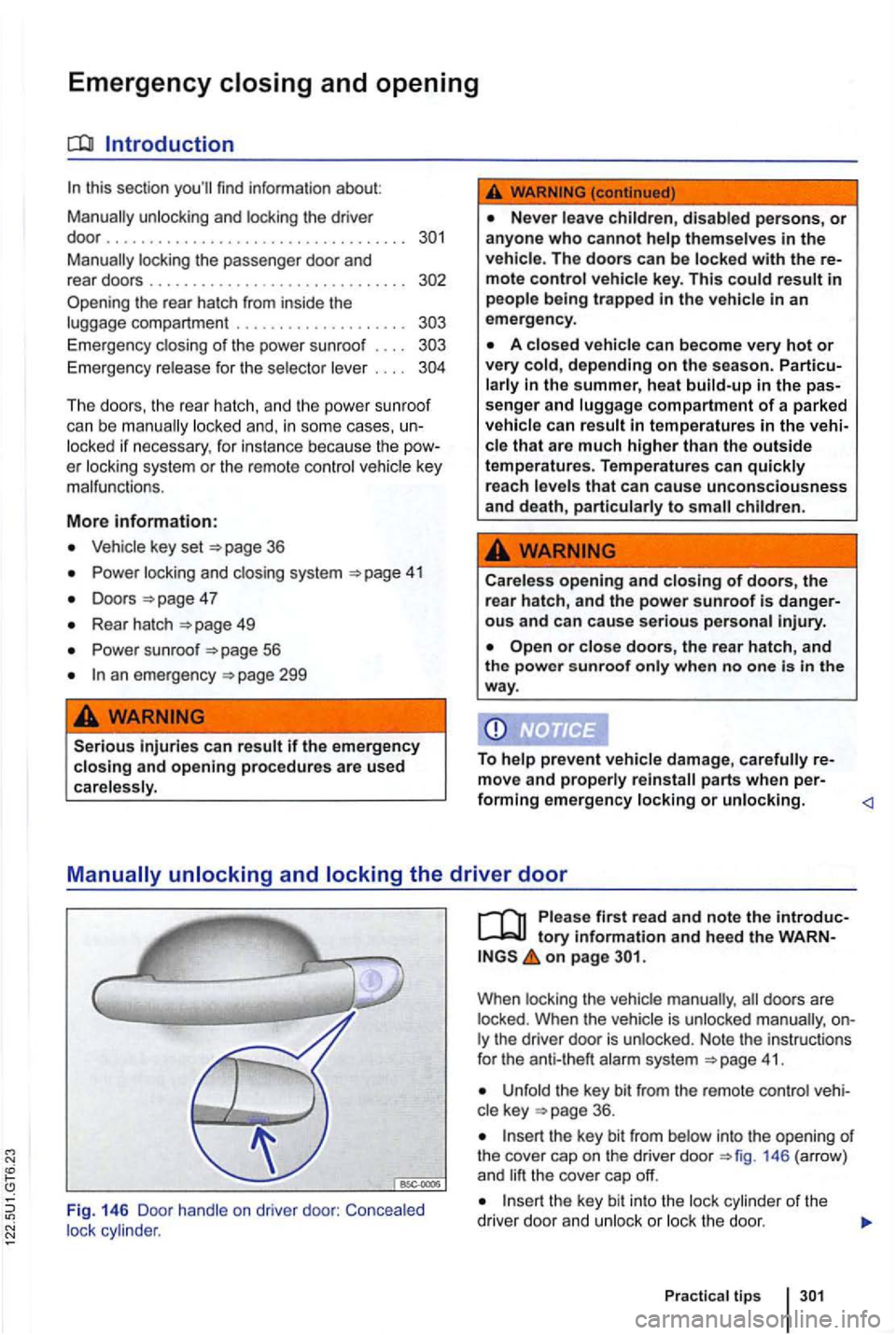2012 VOLKSWAGEN GOLF child lock
[x] Cancel search: child lockPage 185 of 516

the BAG
to make certain
tha t the light stays
on continuously whenever the ignition is on.
BAG the time , stop as soon as it is safe to do so AND
reactivate the airbag system by turning the tion off for more than 4 seconds and then turning it
on again ;
remove and
facturer 's instruc tions ;
make sure t hat the switchab le locking feature
on the safety
has been
make sure that things that may increase the
weight of the child and child seat are not being
t r ansported on the front passenger seat;
make sure that the safety buck le on the
front passenge r seat back and fort h;
make sure that nothing can interfere with the
safety buckles and that they are not ed;
if a strap is being used to tie the child sea t to the fron t passenger seat, make sure that it is not so tigh t that it cau ses the weight-se nsin g mat to
measure more weight tha n is on th e seat.
light does not come on ...
the ligh t does
not come on and does not stay on continuously
(when the ignition is switched on). take the child
rest raint off the front passenger seat and
it
properly at one of the rear seat posi tions . Have the
airbag system in spec ted immedia te ly by your thorized Facil ity .
The light should come on ...
The
BAG ligh t should
BAG light comes on and stays on
under these circumstances , make sure that:
the adult on the front passenge r seat is seated on the center of th e seat cushion with his
o r her back up against the backrest and the
the
the safety is being properly worn and that
there is not a of slack in the safety webbing;
accessory seat cove rs or cushions or othe r things th at may cause an incorrect read ing or
holstery of the seat have been taken off the front
passenge r seat;
the optional safety in th e safety
for ab out 5 seconds to ca tc h the drive r's atten-tion.
the light does not go off when an adult who is not very is sitti ng on th e front passenger seat
afte r t aking the s teps describ ed above, m ake
s u re the adult i s properly sea te d and re strain-ed at on e of the rear sea ting positions.
H ave t he a irbag syst e m ins pecte d by your
authorize d
senger se at dete cts an empty seat, the front
airbag on the passenger side
light
the optional safety extender is in the
buckle for the front safety or the front ger safety senger seat is not occupied , the BAG light come on.
Page 208 of 516

To reduce the risk of serious injury, always
make sure that the
res tra int is
away from
on page
special ste ps when
a child res train t with the vehicle safety
around the rear head restraint behind the
child restraint to help preven t a child from playing
with the unused and becoming entangled in it 64.
When a child safety
seat is secured on the
just the fron t seat to the s ize of the ch ild safety
the
85 .
se nger seat and it properly at one of the rear sea t positions if the GER light does not stay on.
ately by an authorized Volkswagen dealer or authorized
in Intr oduction on
page 58
a ch ild safet y seat is used on the rear bench,
must be sec ured so that the child in the child restraint cannot reach them
Guide the safety belt webbing behind the head
r est raint of the adjacent seat 64. When doing
so , do not engage the safety belt lock!
Let the belt retractor wind up the safety belt
webbing.
A child in a child restraint
sition where the child restrain t is
Never le t anyone sit at the center rea r
sea ting position if the center rear safety belt
h as been routed around a rear head restraint.
properly and safe ly
Page 214 of 516

Not using a booster seat, using the booster seat improperly, incorrectly a booster seat or using the vehicle safety belt improperly increases the risk of serious person
shoulder.
Always make sure the
as possible across the child's pelvis.
Never belt portion of the safety belt pass over the
Never a child stand or kneel on any seat, for example, the front seat.
Never a chi ld ride in the cargo area of your vehicle.
leaning for
ward, sitting sideways or out of position in any way during a This
BAG light does not come on and stay on, perform the checks described
Take the child restraint off the front passenger seat and it properly at one of the seating positions on the rear seat if the BAG light does not stay on whenever the ignition is switched on.
Always read and heed whenever using a restraint in a vehicle.
Child safety and child restraints.
A
Always secure unused rear seat safety belts out of the reach of children in
Never activate the switchable locking retractor when routing the safety belts around the head restraints.
Never anyone sit at the center rear seating position if the center rear safety belt has been routed around a rea r head restraint.
Be
careful not to activate the switchable locking retractor when routing the sa fety belts
around the head restraints. you to route the belt around the head restraint.
Please first read and note the introductory informat ion and heed the WARNon page
be lts fo r the rear se ats a nd the fr on t pa s
s enger seat mu st b e with th e swi tc h able fea ture to p ro pe rly sec ure child restraints.
p orti on of the 3 po int
res traints that can b e used with lower uni v e rsa l a nch o rag es.
Reg ardle ss of the kind of ch ild restraint that you
use, a lways make s ure that the ch ild res tra int is
p ro perly se cur ed in the vehicle ; o therw ise the child
c oul d be ser ious ly injur ed in a c ras h. Al ways
req uirem ent s regarding the installatio n of ch ild restr aint s.
proper ly and safely 1115
Page 216 of 516

Activating the switchable locking feature
the way out of the retracto r.
While keeping your weight on th e child re
straint , g u ide the shoulder belt portion of the safety
b elt back into the retrac tor until the belt lies flat and
is tightened against the child restraint.
You should hear a noise as the bel t
winds back into the inertia reel of the safety belt re
t ractor . Test the switchable locking feature by ing on the belt. You should no longer be able to the belt out o f the retractor. The switchable
l ocking feature is
on the safety belt to make sure the safety
belt is properly fastened and tight.
Deactivating the switchable locking feature
The switchab le locking featu re for child restraints
the way back into the retractor.
Press the red button on the safety belt buckle .
T he belt tongue
Guide the sa fety belt back by hand so that it
the switch able locking feature should be activat
ed inadvertently , the safety belt must be unfas
tened and guided comple te ly back into its stowed
position to deactivate this feat ure .
Using the wrong restraint or an improperly re strain t can cause seri
o u s pe rsonal injury or d eath in an accid ent.
even if a is not sitting in it. A
in an upright position and securely latched into place and cannot fold forward . Otherwise , the seat backrest with the
whenever using a child restraint in a ve hicle Child safety and child restraints. precautions apply when a
child seat on the front passenge r seat 104 , Child restraints and the Advanced front airbag system.
installed child restraints increase the risk of ser ious per sonal injury and death
in a
properly a nd safe ly 117
Page 240 of 516

Introduction
this section
partment and make sure that the rear seat
ble straps. Never overload the veh ic le . Remember
t hat th e vehicle load, as as how it is ed , can affect vehicle
More information:
Airbag system
Lights
Transporting 137
Trailer towing 149
Tires and whee ls
An open or unlocked luggage compartment poses special risks for
atures can quickly reach levels that can cause unconsciousness or death, particularly to children.
hicle.
can
senger compartment by the front airbags if they inflate. To help reduce the risk of serious personal injury:
objects securely in the
sion.
jects from clothing and bags
Transporting heavy objects causes the
cle capacity weight figures apply when the
load is distributed evenly
Transporting 141
Page 278 of 516

Braking, stopping, and parking
this sectio n
Parking brake . . . . . . . . . . . 182
P arking . . . . . . . . . . . . . .
. . . . . . . . . . . . . . . . . 182
About the brakes . . . . . . . . . . . . . . . . . . . . . . . . 183
Braking assistance systems
Switching
L ock Brake System (ABS) . Br ak e Assist System
(BAS ), Ele ctronic Differential Lock (EDL), R eg ulatio n (ASR) and Electronic C ontrol
(ESC).
More information:
Trai ler towi ng 149
Starting assistance systems 1 95
Tires and whee ls 258
Driving with bad brakes or worn brake pads can cause a and serious personal
injury.
lights up in the instrument cluster display, whether alone or together with a text message, immediately contact an authorized Volkswagen dealer or authorized Facility to have the brake pads checked and, if necessa
ry, replaced .
Parking improperly can cause serious sonal injury.
lock and you
haust system or catalytic converter could
fu el, etc.
riously injure you and your passengers.
sonal injury.
mote control vehicle key, trapping passengers in the vehicle in an emergency. For ample, depending on the time of year, people trapp ed in the vehicle can be exposed to very high or very low temperatures.
children.
Starting, shifting, parking 179
Page 287 of 516

you cannot
clearly see th e brake fluid level in the brake fluid
r eservoir , p lea se see an authorized Volkswagen
dealer or authorized Volkswagen Service Facility.
Th e brake
Br ake fluid must be changed according to the serv
ice schedule in your =>booklet Warranty and Main
tenance . Have the brake fluid ch ecked by an au
t h orized Volkswagen dealer or an aut horized
Volk swage n Service tha t m ee ts the standa rds
Brake failure and reduced brake pe rformance
can be caused by not having enough brake
f luid in the reservoir or by old or incorrect brake fluid.
Always change the brake fluid according to the service sch edule in book-let Warranty and Mainten ance.
Hard braking with old brake fluid may cause vapor lock. Vapor lock reduces braking performance , increases stopping distances
and can even cau se total brak e failure.
Always make sure that only the correct brake fluid is used. standard 14 or standa rd 116
standard s tand ard 116 4, do not use it.
The brake fluid must be new .
Brake fluid is poisonous.
To reduce the risk of poisoning, never use food, beverage or other non-original contain-ers to store brake fluid.
store brake fluid in its clo sed , origi-nat container and keep it out of the reach of children.
Brake fluid will damage vehicle paint. Wipe any brake fluid off vehicle paint immediately.
Brake the envir onment. Brake fluid tha t has leaked out must be col
lec ted and disposed of properly , cable e nvir onmen tal reg ulatio ns.
Page 400 of 516

Emergency closing and opening
Introduction
this sect ion you'll find in forma tion about:
M a
nually u nlock ing and locking t he drive r
do or ...................................
O pen ing the rea r ha tc h from inside the
l uggage compartment . . . . . . . . . . . . . . . . . . . .
Emerge ncy closing of th e powe r sunr oof . . . .
Emergency release for the se lecto r lever . . . .
locke d if necessary , fo r in sta nce beca use the er lock ing syste m or t he r em ote control v e hic le ke y
m alfun ctions .
More information:
Vehicle key set 36
Powe r locki ng and closing system 41
Doo rs
R ea r hatch 49
P owe r sunroo f
Serious injuries can result if the emerge ncy closing and opening procedures are used
carelessly .
Never leave children, disabled persons, or anyone who cannot help themselves in the
vehicle. The doors can be locked with the re-
mote control v eh icle key . This could result in
people being trapped in the vehicle in an
emergency .
A closed ve hicle can become very hot or very cold, depending on the seaso n. Particu-
l arly in the summer, heat build-up in the pas-
senge r and luggage compartment of a parked
vehicle can result in temperatures in the vehi -
c le that are much higher than the outside temperatures. Temp eratures can quickly reach levels that can cause unconsciousness
and death , part icularly to children.
Careless opening and closi ng of doors, the rear hatc h, and the power sunroof is dang er-ous and can cause serious personal injury.
or close doors, the rear hatch , and
th e power sunroof only when no one is in the wa y.
To he
lp prevent vehicle damage , carefully mo ve and properly rein stall parts when per-
forming emergency locking or unlocking .
ly the driver doo r is unl ocked . N ote the instru ction s
fo r the an ti-t heft alarm syste m
Unfold the key bit from the r emote contr ol cle key
th e key bit f ro m below into the open in g of th e cover cap on t he drive r doo r 146 (arrow)
a n d l ift the cove r cap off.
Practical tips